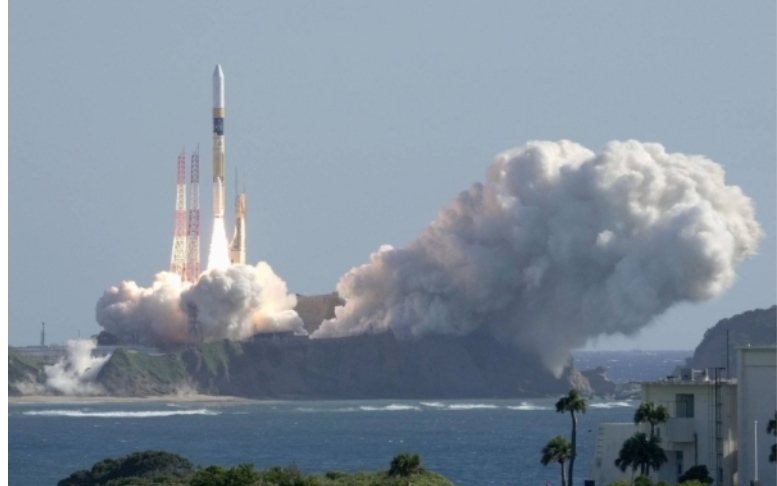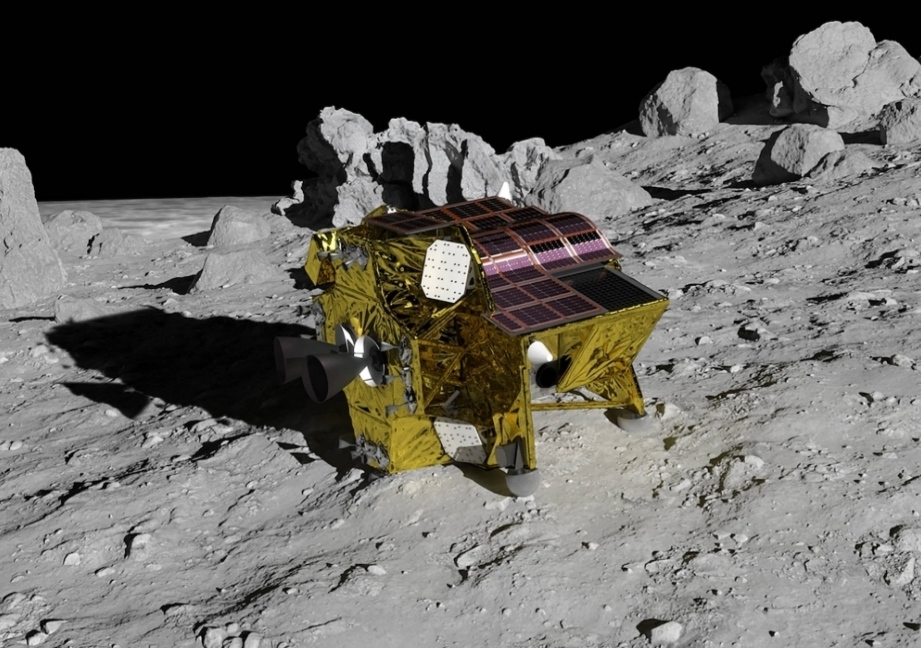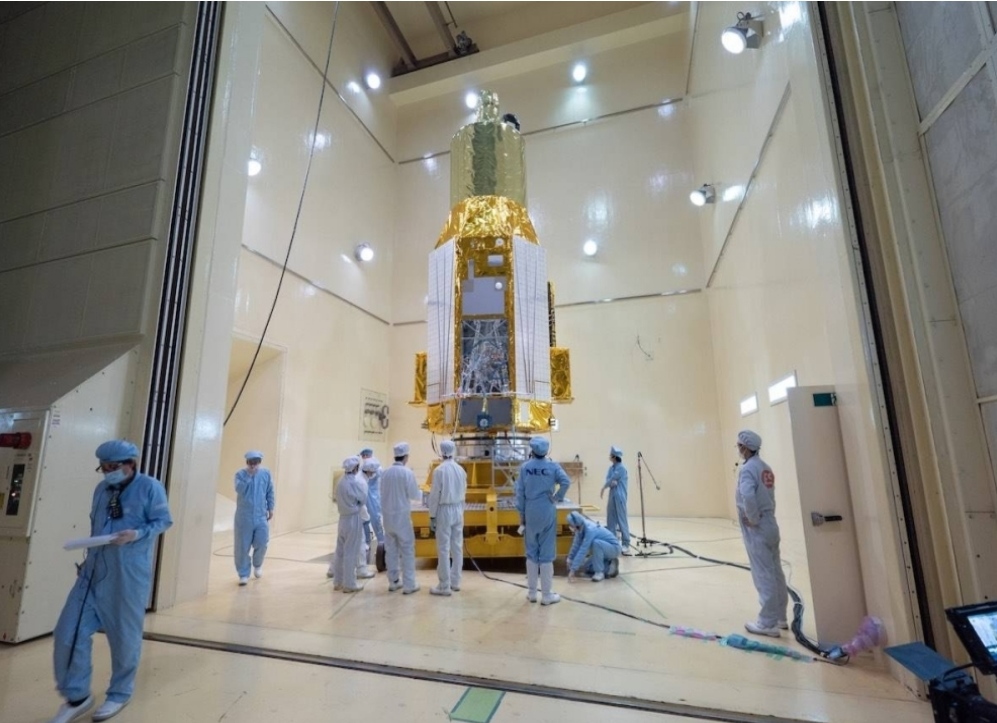Japan finally succeeds in launching its Chandrama Mission

An HII-A rocket, carrying the Smart Lander for Investigating Moon (SLIM) and X-Ray Imaging and Spectroscopy Mission (XRISM), lifts off on Thursday morning from Tanegashima Space Centre in Kagoshima Prefecture.
Japan has finally entered the international space race to land on Chandrama. Just like ISRO of Bharat ( which has a record of launching 108 satellites on a single rocket ), it has been able to launch two missions in a single rocket, one of which could see the country put its first spacecraft on the Chandrama, while the other aims to help shed light on the universe’s origins.
The missions — called the Smart Lander for Investigating Moon (SLIM) and X-Ray Imaging and Spectroscopy Mission (XRISM) — were both launched from Tanegashima Space Centre in Kagoshima Prefecture at 8:42 a.m. atop an HII-A rocket, following several postponements due to adverse weather.
Dubbed “moon sniper,” the SLIM project involves using advanced image-based navigation technology and lightweight hardware to demonstrate high-precision landing and obstacle-detection techniques by a small Chandrama lander.
XRISM, meanwhile, aims to use a satellite equipped with next-generation X-ray imaging spectroscopy technologies to study plasma in stars and galaxy clusters in the hope of answering questions such as how the largest structures in the universe evolved and how galaxies are shaped by massive black holes at their centres.
The launch of the XRISM satellite, which will operate in a low-Prithvi orbit for at least three years, is a joint mission between JAXA and NASA, along with participation from the European Space Agency and Canadian Space Agency.
While XRISM will follow purely scientific purposes, SLIM has both scientific and operational objectives.

An artist’s concept of Japan’s Smart Lander for Investigating chandrama
Weighing a little more than 700 kilograms — less than half of conventional landers — the SLIM craft is expected to touch down within only 100 meters of its target point, the slope of the Shioli crater, near Chandrama sea Mare Nectaris. This ambitious targeting is far more narrow than the usual range of several kilometers.
“By creating the SLIM lander, humans will make a qualitative shift towards being able to land where we want and not just where it is easy to land, as had been the case before,” the Japan Aerospace Exploration Agency (JAXA), which developed the lander, said on its website, adding that such a capability will also help accelerate the study of Chandrama and planets using lighter exploration systems.
Indeed, the reduced weight of future probes will be essential to redistribute resources for observational devices. Building a lighter lander could also reduce launch costs, allowing for more frequent missions.
At the same time, a successful landing would contribute valuable data to Artemis, the U.S.-led, multinational program that aims to return astronauts to Chandrama as early as 2025 and establish a sustainable presence there to prepare missions to Mangal and facilitate deep-space exploration.
Chandrama missions are extraordinarily complex,” said Pablo de León, professor and chair at the University of North Dakota’s Department of Space Studies. Trying to master techniques of precisely landing on the Chandrama will be of great importance in the near future.
This is particularly significant for efforts to build a lunar base camp under the Artemis program, he added. “You will need to be able to bring crews and equipment as close as possible from the lunar settlement, and this is what this mission will demonstrate.”
Just like ISRO mission, SLIM is set to land on Chandrama four to six months from now. The reason for the long duration is that the craft will use its own propulsion system to perform adjustments, adopting a flight path that minimizes propellant consumption.
During the landing phase it will use “vision-based navigation” to recognize where it is flying and employ an autonomous image-based system to correct its position and avoid hazardous rocks and obstacles, a move that was followed by ISRO scientists.
The SLIM mission, which is also expected to study minerals and other elements on the Chandrama’s surface, is Tokyo’s second attempt at a Chandraman landing in recent months.

The spacecraft for the Japanese-led X-ray Imaging and Spectroscopy Mission (XRISM), undergoes acoustic testing. The telescope will help astronomers study some of the most energetic places in the cosmos, while the lunar mission will aid the development of Japanese landing technologies. | JAXA / VIA THE NEW YORK TIMES
While Japan is among the world’s top space-faring nations, it has suffered a series of setbacks, including the failed moon-landing attempt in April by Tokyo-based ispace, the explosion of an Epsilon S small rocket engine during a July test and JAXA’s decision in March to destroy its flagship medium-lift H3 rocket due to engine ignition trouble.
“Without medium-lift capability, Japan’s space missions will have to innovate to send lighter missions,” said Namrata Goswami, a space policy expert and professor at the Thunderbird School of Global Management at Arizona State University. “At the same time, this will limit the country’s ability to launch more ambitious missions to space.”
If successful, the SLIM mission would make Japan only the fifth nation to land a probe on the moon after the United States, Russia, China and more recently India, with its Chandrayaan-3 mission.
SLIM, however, is only the latest of Japan’s planned missions to further lunar exploration. The country will be joining forces with India for the Lunar Polar Exploration mission set for launch sometime after 2025.
LUPEX’s goal is to obtain data on the quantity, distribution and forms of the water present on the moon to determine if they can be utilized for sustainable space exploration activities.
But perhaps Japan’s greatest contributions in the area will take place under Artemis, an important component of which will be the multinational Lunar Gateway project aimed at developing a research outpost orbiting the moon that would be used to prepare for Mars missions.
Last November, Tokyo signed an agreement with Washington formalizing Japan’s contributions to the project, which will also lead to a Japanese astronaut aboard the outpost and another joining a mission to the lunar surface, making Japan only the second country to set boots on the moon after the U.S.
This comes as Tokyo and Washington are locked in a geostrategic competition with China, which is rapidly advancing its own space capabilities to catch up with and eventually surpass the U.S. as the dominant space power.
Although Beijing insists that it plans to use space for peaceful purposes and scientific advancements, the emergence of an undemocratic and autocratic China as a space power is seen by Tokyo and Washington as a potential security risk, particularly given the dual-use nature of the space technologies being developed, the Chinese military’s prominence in the domestic space industry and Beijing’s lack of transparency.
The Asian powerhouse has announced several ambitious plans for the coming years, including collecting near-Earth asteroid samples and conducting two lunar polar exploration missions by 2025. It also plans to launch a Mars sample-return mission, send an unmanned probe to Jupiter and land astronauts on the moon by 2030.
Besides scientific exploration, one of the future goals of moon missions will be to explore the possibility of extracting lunar resources and use them either for sustainable space exploration or economic profit. The push has resulted in something of a new space race between nations such as the U.S., India, China, Russia and Japan.
“These nations now have, or are trying to obtain, the technology that will facilitate prospection and mining of lunar resources,” said De Leon.
“This will bring an unprecedented new era in space exploration,” he added.
“We cannot yet envision the exact benefits, but it will bring new economic opportunities to all nations involved.”
BY GABRIEL DOMINGUEZ




